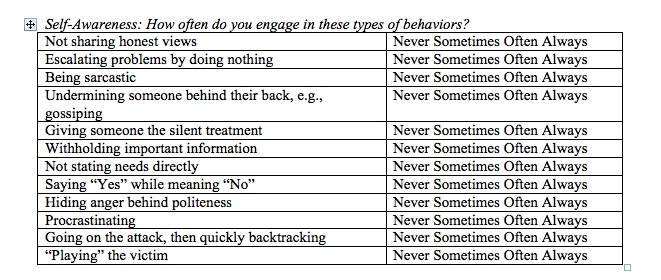
I confess. I lost my temper recently with someone I love. I was feeling exhausted from a long flight, and instead of telling me what she wanted, she just gave me long, freezing—and I mean deep freezing—look. I got angry at her passive-aggressiveness (PA). She was acting out non-verbally, but denying anything was wrong.
What is PA? Indirect resistance to the demands of others, and an avoidance of direct confrontation. In other words, it is resentment behind a mask.
Hands up, those who have experienced PA? Hands up if you have been PA. I see raised hands; the rest of you are lying!
- Passive-aggressive behavior comes in many forms. You might find patterns that include some of the following:
- Not sharing honest views
- Escalating problems by doing nothing
- Being sarcastic
- Undermining someone behind their back, e.g., gossiping
- Giving someone the silent treatment
- Withholding important information
- Not stating needs directly
- Saying “Yes” while meaning “No”
- Hiding anger behind politeness
- Procrastinating
- Going on the attack, then quickly backtracking
- Playing the victim
See the self-awareness questionnaire at the end of this article.
What to Do?
- Learn how to recognize PA behavior. I’m reminded of the phrase, “People may not always tell you how they feel about you, but they will always show you. Pay attention.” Look for behaviors like those listed above in yourself, as well as others. Try to identify PA behavior early in a relationship. Once a PA pattern is established, it becomes more difficult to break.
- Stay calm and positive. PA behaviors can make you crazy and trap you in a spiral of negativity. An angry response usually puts the focus on you, when what you need is a focus on the other person’s behavior. Calm assertiveness speaks volumes about your strength and unwillingness to be manipulated. I failed miserably in the story I told at the beginning of this article, but I’m learning!
- Be open and direct about your emotions, without being emotional. Focus on how their behavior makes you feel, by using “I” rather than “You” statements. “You” statements imply an accusation, and will only lead to defensiveness rather than the productive conversation needed. “I feel something is upsetting you,” is non-threatening. You also won’t make any headway by adopting a PA attitude yourself, e.g., being sarcastic or rolling your eyes.
- Try to get the person to acknowledge he or she is upset. Do this in a non-confrontational way: “I may be wrong, but you seem to be upset that you didn’t get invited to ___________.” Uncovering and exploring the anger behind the mask directly and constructively is the only way forward. You might need to ask a lot of open-ended and non-judgmental questions to get beyond their denial. This may take time because PA people usually have not learned to express their feelings and needs directly; sometimes they want you to read their minds.
- Don’t take the behavior personally. There can be all sorts of reasons why a person behaves in a PA manner—many of which may have nothing to do with you (e.g., their background and current life situation). You also might be the most conveniently available person they can direct their PA toward. You can dig for the real cause(s) of the behavior, but be careful. You are not a therapist, and may not be able to deal with the fallout. Also, avoid topics that are sensitive or revealing of your own personal weaknesses; the information you share could come back to haunt you.
- Set limits. You don’t want to normalize PA behavior, so be firm about your boundaries. Never be a victim. You are not a punching bag on which others can vent their frustrations—even indirectly—no matter how empowered it makes them feel. You must ask specifically for what you want in a way that is non-threatening and respectful, but never sink into passivity yourself. PA people tend to target conflict avoiders because they find it relatively easy to push their buttons. Don’t be timid—it is perfectly reasonable to lay out the consequences of their continued PA behavior.
- Co-opt the PA person. Many who demonstrate PA behavior do so because they feel they have no voice, and are not listened to. Learned helplessness is common among PA people. Try to engage them more directly in discussions: “How do you think we should handle this problem?” You can hope for constructive input, but if all you hear is indirect negativity, move on: “I hear what you’re saying, and I’ll take your thoughts into account.”
- Reinforce appropriate behavior. Be the role model by being open, clear about expectations, direct, respectful, non-complaining, proactive, and a problem solver.
Why is it important to act decisively about a PA colleague? The simple answer is that while PA behavior is a form of self-sabotage, it is also highly toxic on a team—communication, morale, and productivity suffer.
You don’t have to tackle PA alone. You can engage the team in establishing norms of behavior that encourage direct and honest interactions. Team members can help keep one another accountable; peer pressure can influence more strongly than the individual leader. If that doesn’t work, more drastic actions may be necessary.
How do you think your colleagues would respond to your answers to the following questionnaire?

Terence Brake is the director of Learning & Innovation, TMA World (http://www.tmaworld.com/training-solutions/), which provides blended learning solutions for developing talent with borderless working capabilities. Brake specializes in the globalization process and organizational design, cross-cultural management, global leadership, transnational teamwork, and the borderless workplace. He has designed, developed, and delivered training programmes for numerous Fortune 500 clients in the United States, Europe, and Asia. Brake is the author of six books on international management, including “Where in the World Is My Team?” (Wiley, 2009) and e-book “The Borderless Workplace.”




